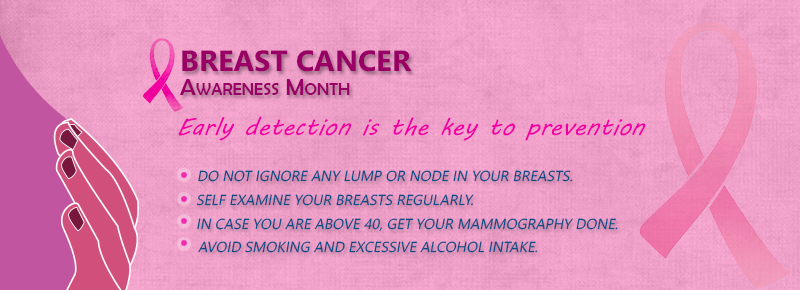Pink Ribbon Month: The Fight Against Breast Cancer

Share
October is Breast Cancer Awareness Month, an annual international campaign organized by major breast cancer charities to increase awareness of the disease and raise funds for research into its origin. At this year we want you all involved in our efforts through a blog post discussing general public issues with breast cancer as well as challenges associated with trying solve these mysteries today that scientists are tackling head on!
Breast cancer is the most common form of cancer among women, and it can affect anyone regardless of age or race. Breast cancer affects one in eight women at some point in their lives, which makes awareness all the more important. The month-long event aims to educate people about breast health practices - from mammograms to self-exams - as well as encourage early detection for those who have a family history that puts them at risk for developing breast cancer.
National Breast Cancer Awareness month is all about making people aware of the challenges that remain. It’s also important to remember those who have gone through this difficult time in their lives and how it has shaped them as individuals today - both good things like happy memories or bad ones such as anger issues following treatment. The point I would take away from this celebration if for simply living each day with an attitude focused not just on myself but others around me too; looking outwards rather than solely inwardly when trying resolve problems which ultimately could lead up toward solving mysteries surrounding human behavior (and maybe even learning something new).
In the United States alone, breast cancer has claimed 42000 lives. In North America nearly 279 000 women and men are expected to be diagnosed with this disease; yet despite these staggering statistics it’s important not only for people living a healthy lifestyle - but also their loved ones too-to maintain an active screening schedule because early detection can save your life!
Research grants have helped scientists better understand breast cancer and develop treatments that save lives. As a result, more people are being saved every day which is an amazing thing to witness! But there's still work ahead of us in order for this trend continue on its upward trajectory- let's make sure our government doesn't get in the way with unnecessary regulations or taxation schemes so they can help even MORE families live their best possible life today!
What is breast cancer?
Breast cancer is a disease where the cells in the breast tissue grow out of control. As they do, these malignant tumors can form and cause problems for both women and their loved ones who are affected by it: some cancers may be found early because there might not yet be any symptoms; others may have been growing so long before being detected that removing them would mean sacrificing either quality life or even limb due to size/numbers issues.
Invasive breast cancer is a terrifying and life-threatening disease. The cells of these tumors can spread into the surrounding breast tissue, which means that they're much more likely than noninvasive (benign) forms to cause invasion; this occurs when those invasive cancers break away from their original location within the body's natural borders--usually courtesy an indented edge or architectural feature such as muscle Gilmore Friedman syndrome may increase your risk for developing genetic alterations called numerical chromosomal aberrations such as deletion paternal unclemic twins If you've been diagnosed with hereditary allelic variation. This process is called metastasis and leads to metastatic breast cancer. Breast exams aren't always enough when looking at detecting Breast Cancers.
How do you get it?
There's a lot of mystery around breast cancer, but the truth is that nobody really knows why it happens. It has been shown to develop as a result from a gene mutation and while scientists have found some clues in regards with this research topic there are still many unanswered questions left for them to explore further on how we can prevent these types if diseases going forward.
About 5-10% of breast cancer cases are due to inheritance from parents, but 90 - 95% occur as a result of spontaneous gene mutations. We don't know what causes these changes in DNA so it's hard for doctors and researchers alike to find any solutions that will work on this specific type or pattern. Researchers have been looking into various types proteins within cells which might be linked with increased risk factors including obesity/salt intake; diethyl hexanoate (DEHA).
It is possible that the reason may be due to your lifestyle or exposure to an environmental toxin. However, this would not allow us any prevention methods in order understand them; therefore preventing future outbreaks of these conditions.
Why should someone with no history care about breast cancer?
We all know that there are certain factors which increase our chance of getting breast cancer such as having an inherited gene mutation or being overweight as adults, but not everyone with those traits will develop the disease. However it's important to remember many other people don't have these risks and they too can live long lives without incident! Breast cancer is the most common type of gynecological malignancy among women. However, it can occur in men and young females as well with a higher frequency than expected for their population size because there are two risks that increase one’s chances: being female or getting older.
So, you might be wondering what it means if your family tree is clear of breast cancer? In a word: prevention. It’s important for everyone to know they can get this disease and preventive measures such as eating right or exercising may help keep the risk level down but there will always come a time when we all need treatment no matter how healthy we are because even though some cancers have genes which make them more likely than others; none us ever fully escape its clutches!

The number of people(Including men, and women) who will be diagnosed with breast cancer this year is expected to reach 279,000 in the U.S alone. And chances are that you know someone affected by the disease already!
What should you know about the disease?
Advances in breast cancer research have given us a better understanding of the disease, but there’s still much to learn about it. It's not just one disease anymore; rather this family includes different personality disorders that affect how they present themselves and act accordingly.
Breast cancer is one of the most common cancers in women, and new research has discovered at least six more sub-types that can be used to describe it. One type may even have been previously unknown! The discovery was made possible by studying over 2 million cases from around the world as part if an effort called " Conquer Your Cancer ." This project aims not only learn about different types but also develop specific treatments for each so we're better able kill off those pesky cells before they grow into problems again—preventing recurrence or coming back after treatment.
Breast cancer is a devastating illness that can strike anyone, at any time. The good news? We know how to find it early! Mammograms have been shown effective in identifying cancers up-to 10 years before they become large enough for you feel - this means there's more treatment options and the outcomes tend be better too. Breast disease doesn't discriminate between our gender or age; we all deserve access to quality healthcare because of this fact alone.
The mystery of the cancerous breast is deep and complex, but we're on a new frontier in our understanding. We still don’t know why some forms go into hiding only to come back decades later as metastatic disease—and this makes me feel both hopeful for myself because there could be things out there that will help my own case one day; yet also concerned about those patients who have already had long battles with their illness before finally gaining control over it many years ago. The problem was so prevalent until recently- people often didn't even realize how much more than just simply getting mammograms did doctors actually do during an appointment!
As per the Komen's research with a 40% higher mortality rate, we don’t know why Black women are at such an elevated risk for breast cancer. This year more than 42,000 people will die of the disease and there still has been no explanation as to what causes this discrepancy between races- it defies all understanding!
The survival rates of breast cancer patients have greatly improved in the last decades. With successful prevention programs and early detection, more people are surviving their diagnosis than ever before!

There is a new awareness in the medical community that early detection can increase your chances for successful management and cure. This has been proven through research, as 90% of deaths due to breast cancer are linked with late stage diagnoses; stages III or IV where it may have spread elsewhere on body too such as vital organs like kidneys and lungs among other things (which makes prevention an even higher priority).
Towards personalized medicine
It has become clear that breast cancer is not one disease, but rather a variety of subtypes which require different treatments. Recently the idea to personalize or individualized therapy for advanced stage patients was developed as it became increasingly apparent how each tumor evolved differently in every person's body resulting into better cure rates with these customized approaches than before when all cancers were viewed under generic categories like " hormone receptor positive"
New technique facilitates therapy personalization
Personalizing a therapy consists of learning the unique cellular and molecular composition of your patient's tumor before designing an optimal treatment for this person accordingly. Personalized treatments can be difficult to implement in practice because they are time consuming, very expensive with health care systems; however these therapies have great potential if more research goes into them or their implementation becomes easier without sacrificing effectiveness.
It was once thought that a cancerous tumor could only tolerate one drug at a time, but it's now been proven otherwise. In fact there are many different types of medication with varying effects which can be tested on these patients without risking too much harm or side-effects from the treatment in general population studies where researchers usually use comparator drugs - meaning compared to other treatments being studied for comparison purposes.
In an article published in BMC Cancer this year, the authors describe how they were able test new combinations using this surgical removal technique after identifying patient’s unique genetic signature within their malignant cells themselves before surgery took place.
The researchers developed a way to maintain living tissues in patients with breast tumors, which can then be tested for optimal therapies. This method is particularly relevant as it allows doctors avoid wasting time and suffering unpleasant side effects by using ineffective treatments on their patient; saving both the woman's valuable energy levels while still providing quality care. The scientists discovered something amazing after decades of research: they've created artificial "living sections" from human mammogram images so you don't need individual cells or organs anymore!
Improving clinical practice
The future of breast cancer treatment is now in the hands of scientists and doctors. The most up-to date advances coming out laboratories promise to help patients live longer, healthier lives with better chances for prevention or diagnosis at an early stage when it can be treated more effectively than ever before!
Prevention: body weight remains a top risk factor in breast cancer
Breast cancer is the most common type of cancer in America, but it's also preventable. One third of all types can be avoided by modifying your diet and exercise habits. Looking at prevention as one possible way to reduce our risks for developing breast disease makes sense because research has identified risk factors associated with this particular form including eating well or exercising regularly- something worth considering if you don't already do these things!
The recent publication of a new study has shown that being overweight or obese is linked to an increased risk in later life for breast cancer. The researchers conducted a large population survey including 739 cases from patients who were diagnosed with this type if disease, compared against 815 healthy women of various ages at one point during their lives- before they had been diagnosed. Weight variations among subjects studied included changes over time such as premenopausal weight loss followed by significant postmenopause gain(>40kg).
A bright future ahead
It is a well-known fact that people nowadays live longer than they used too, thanks to the advancements in healthcare. With an ageing global population and more cases of breast cancer on route; we might see this trend continue for years into coming centuries as well! As covered here you can learn about some prevention techniques which could help eradicate one of humanity's most dreaded diseases: Breast Cancer. Every death from breast cancer is a tragedy, but it would not be tragic if we all had access to the knowledge and resources needed for prevention programs. Public awareness must continue as well because there has been little progress in late stage research of this disease since 1985!

We hope that through exploring our article about Breast Cancer Awareness, you have been able to take a more enthusiastic stance in your support for this cause.
Follow us for more information and updates, wristwatchstraps.










